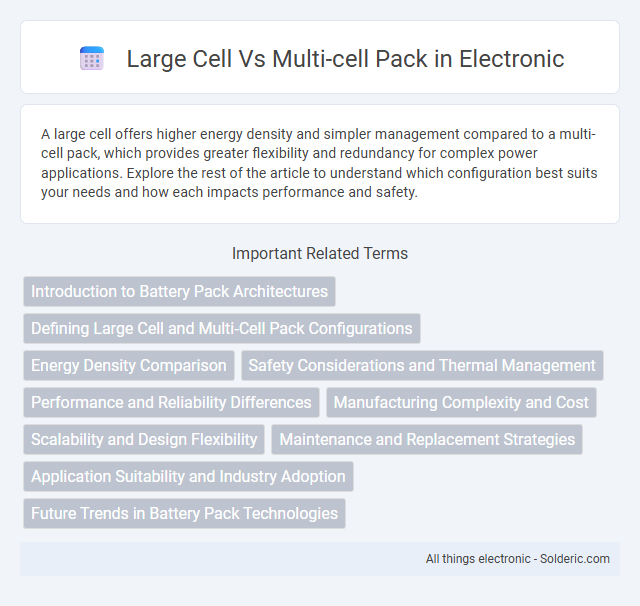A large cell offers higher energy density and simpler management compared to a multi-cell pack, which provides greater flexibility and redundancy for complex power applications. Explore the rest of the article to understand which configuration best suits your needs and how each impacts performance and safety.
Comparison Table
| Feature | Large Cell | Multi-Cell Pack |
|---|---|---|
| Definition | Single large battery cell with high capacity. | Multiple smaller cells assembled into a pack. |
| Energy Density | Typically higher energy density per cell. | Variable; dependent on cell arrangement and type. |
| Thermal Management | Challenging due to concentrated heat in one cell. | Easier with distributed heat across multiple cells. |
| Scalability | Limited by cell size and manufacturing constraints. | Highly scalable by adding more cells. |
| Maintenance | Single cell failure affects full capacity. | Individual cell replacement possible, improving reliability. |
| Cost | Higher per cell cost; less modular. | Lower per cell cost; modular and flexible. |
| Applications | Used in large industrial batteries and electric vehicles. | Common in portable electronics, EVs, and energy storage. |
Introduction to Battery Pack Architectures
Large cell battery packs utilize fewer, high-capacity cells arranged in series or parallel, offering simplified management and potentially lower costs. Multi-cell packs consist of numerous smaller cells configured to balance energy density, thermal management, and safety, which enhances overall performance and longevity. Your choice between these architectures influences factors like pack scalability, maintenance complexity, and thermal regulation efficiency.
Defining Large Cell and Multi-Cell Pack Configurations
Large cell battery configurations consist of fewer, physically bigger cells designed to deliver high capacity and simplified thermal management, often used in electric vehicles and energy storage systems. Multi-cell pack configurations integrate numerous smaller cells arranged in series and parallel to achieve higher voltages and capacities with greater flexibility and redundancy. Understanding your application's power and size requirements is essential when choosing between large cell and multi-cell pack architectures for optimal performance and reliability.
Energy Density Comparison
Large cell packs typically offer higher energy density per individual cell, resulting in a more compact battery design with improved weight-to-capacity ratios. Multi-cell packs, while providing flexibility in configuration, often experience reduced overall energy density due to additional packaging materials and inter-cell connections. Your choice between large cell and multi-cell packs will significantly impact the total energy capacity and space efficiency of your battery system.
Safety Considerations and Thermal Management
Large cell battery packs offer simplified thermal management due to fewer interconnections, but pose higher risks of thermal runaway propagation if one cell fails, requiring robust cooling systems and protective circuitry. Multi-cell packs, composed of smaller cells connected in series or parallel, enable better heat dissipation and more granular safety monitoring through individual cell management, reducing the impact of single-cell failures. Effective thermal management in both designs is critical, typically involving liquid cooling or phase change materials to maintain cell temperature within safe operating limits and prevent degradation or catastrophic failure.
Performance and Reliability Differences
Large cell batteries offer higher energy density and faster charge-discharge rates, enhancing overall performance compared to multi-cell packs. Reliability favors multi-cell packs as they provide better fault tolerance and thermal management through individual cell monitoring and balancing. Performance degradation in large cells is more pronounced due to the single point of failure risk, whereas multi-cell configurations distribute stress, improving longevity and safety.
Manufacturing Complexity and Cost
Large cell batteries feature simpler manufacturing processes due to fewer individual components, resulting in lower production costs and reduced assembly time. Multi-cell packs require intricate assembly with numerous cells, complex balancing circuits, and enhanced safety measures, which increases both manufacturing complexity and overall cost. This complexity drives higher labor intensity and quality control requirements in multi-cell pack production compared to large cell formats.
Scalability and Design Flexibility
Large cell battery packs offer streamlined scalability with fewer interconnections, enabling straightforward expansion and reduced complexity in design. Multi-cell packs provide greater design flexibility by allowing varied cell configurations and shapes to fit specific form factors or performance requirements. Choosing between the two depends on the application's demand for modular scalability versus tailored design adaptability.
Maintenance and Replacement Strategies
Large cell battery packs require less frequent maintenance due to their simpler design but can be costlier to replace when individual cells fail. Multi-cell packs allow targeted replacement of faulty cells, reducing downtime and repair costs, though they demand more regular monitoring and balancing to ensure optimal performance. Your choice between the two impacts long-term maintenance efficiency and overall replacement strategy expenses.
Application Suitability and Industry Adoption
Large cell batteries offer higher energy density and are ideal for applications requiring compact, lightweight power sources such as electric vehicles and aerospace industries. Multi-cell packs provide enhanced scalability and flexibility, making them suitable for renewable energy storage, industrial equipment, and consumer electronics where modularity and maintenance are critical. Your choice depends on whether you prioritize space efficiency or ease of customization and integration within industry-standard systems.
Future Trends in Battery Pack Technologies
Large cell battery packs offer improved energy density and simplified thermal management, making them ideal for electric vehicles aiming for longer range and faster charging. Multi-cell packs provide enhanced modularity and fault tolerance, supporting scalable designs for diverse applications such as grid storage and hybrid electric systems. Future trends emphasize integrating solid-state electrolytes and advanced battery management systems to boost safety, efficiency, and lifecycle in both large cell and multi-cell configurations.
Large cell vs Multi-cell pack Infographic

 solderic.com
solderic.com